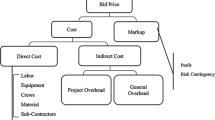Abstract
The causes of contract change at the construction phase can become the main risk factor which was not accurately understood or was unexpected leading to the increase in the direct and/or indirect costs. Therefore the contingency is necessary to swiftly handle and respond to such occasion However, when it comes to estimating contingency, it is difficult to respond to risks arising variously depending on the nature of the project. This is because the assessment method is based on lump-sum ratio application. To address such problems, the final contingency estimation system has been established using contingency estimation modeling based on the analysis on the current contract change status and on the results of identification and analysis of cost overrun risk. To verify the usability of the constructed system, case study has been performed targeting risk management experts. As a result of case application, it was possible to provide the information on the relevant project in advance, to derive the cost overrun factors, to identify the risk factors in detail, and thus to understand the nature of project by analyzing the contract change status in public construction projects. Furthermore, this method is differentiated from the traditional lump-sum ratio application because the accuracy of risk analysis improved by using 3 input variables instead of single variable and by putting risk analysis methods together (importance analysis+ fuzzy theory).
Similar content being viewed by others
References
Chae, S. W. (2006). High-speed integer operation in the fuzzy consequent part and the defuzzification stage for intelligent systems, MSc Thesis, University of Hannam, Daejeon, Korea.
Dikmen, I., Birgonul, M. T., and Han, S. (2007). “Using fuzzy risk assessment to rate cost overrun risk in international construction projects.” International Journal of Project Management, Vol. 25, Issue 5, pp.494–505, DOI: 10.1016/j.ijproman.2006.12.002
Frimpong, Y., Oluwoye, J., and Crawford, L, (2003). “Causes of delay and cost overruns in construction of ground water projects in a developing countries: Ghana as a case study.” International Journal of Project Management, Vol. 21, Issue 5, pp.321–326, DOI: 10.1016/S0263-7863(02)00055-8
Hsieh, T.-Y., Lu, S.-T., and Wu, C.-H. (2004). “Statistical analysis of causes for change orders in metropolitan public works.” International Journal of Project Management, Vol. 22, Issue 8, pp.679–686, DOI: 10.1016/j.ijproman.2004.03.005
Hwang, J. S. (2003). A risk management methodology using fuzzy theory for early construction stage, MSc Thesis, University of Incheon, Incheon, Korea.
Idrus, A., Nuruddin, M. F., and Rohman, M. A. (2011). “Development of project cost contingency estimation model using risk analysis and fuzzy expert system.” Expert Systems with Applications, Vol. 38, Issue 3, pp.1501–1508, DOI: 10.1016/j.eswa.2010.07.061
Jang, D. H. (2010). Study on the Threat-level assessment model development using Fuzzy Theory, MSc Thesis, University of Hansung, Seoul, Korea.
Jung, J. H. and Lee, H. K. (2011). “A study on the analysis of contract changing situation for public construction project.” Journal of the Regional Association of Architectural Institute of Korea, Vol. 13, Issue 4, pp.315–322.
Jung, J. H. and Lee, H. K. (2012). “Identification analysis of cost overrun risk through cause analysis of contract change of public construction project.” Journal of the Regional Association of Architectural Institute of Korea, Vol. 14, Issue 3, pp.277–286.
Kim, C. H., Lee, B. H., and Kang, L. S. (1999). “Contingency estimating through risk analysis of construction projects.” KSCE Journal of Civil Engineering, Vol. 19, Issues 1–5, pp.813–823.
Lee, M.-H. (2007). Constitution of decision support process for the contingency management on the apartment housing, PhD Thesis, University of Donga, Busan, Korea.
Lee, S. K. (2010). A conflict-risk assessment model for urban regeneration projects using Fuzzy-FMEA, MSc Thesis, University of Kwangwoon, Seoul, Korea.
Mak, S. and Piken, D. (2000). “Using risk analysis to determine construction project contingency.” Journal of Construction Engineering and Management, Vol. 126, Issue 2, pp.130–136, DOI: 10.1061/(ASCE)0733-9364
Xua, K., Tanga, L. C., Xiea, M., Hoa, S. L., and Zhub, M. L. (2002). “Fuzzy assessment of FMEA for engine systems.” Reliability Engineering & System Safety, Vol. 75, Issue 1, pp.17–29, DOI: 10.1016/S0951-8320(01)00101-6
Author information
Authors and Affiliations
Corresponding author
Rights and permissions
About this article
Cite this article
Jung, J.H., Kim, D.Y. & Lee, H.K. The computer-based contingency estimation through analysis cost overrun risk of public construction project. KSCE J Civ Eng 20, 1119–1130 (2016). https://doi.org/10.1007/s12205-015-0184-8
Received:
Revised:
Accepted:
Published:
Issue Date:
DOI: https://doi.org/10.1007/s12205-015-0184-8




